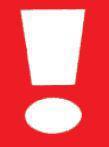SAS Urban Survival Handbook (11 page)
Read SAS Urban Survival Handbook Online
Authors: John Wiseman
Tags: #Health & Fitness, #Reference, #Survival, #Fiction, #Safety, #Self-Help, #Personal & Practical Guides, #General, #Survival Skills

Power supplies, electrical sockets and plugs vary the world over. In the UK and Australia, for example, voltages are very similar and both use three-pin plugs. The important difference is that plugs are not fused in Australia—whereas they always are in the UK. In the US, not only is the voltage lower, but plugs are two-pin and unfused. Switches on lamps may be turn buttons, not rocker switches or press buttons. Room switches may operate in the opposite direction to the UK. ‘Up’ may be ON, while ‘down’ is OFF. All could lead to confusion and mistakes could be dangerous.
If travelling or emigrating, be aware of national variations. KNOW YOUR DESTINATION!
Types of domestic circuit
The electricity supply enters a premises through a sealed service fuse box (to which only the electricity company has access), passes through the meter (which records the current used) and travels through a set of fuses, before being distributed about the building.
Very old systems had separate fuses for each outlet. Power (socket) and lighting circuits, even quite recently, had separate fuse boxes. A messy fuse board may indicate old, messy or dangerous wiring.
A modern system usually has a single fuse box, or consumer unit, linked to a smaller number of circuits, with each circuit protected by a fuse or circuit-breaker. Each appliance is protected by a fuse in its plug. Alternatively the actual socket (or special switch) may also be fused.
Heavy cable is used to serve a number of outlets, which are usually arranged as a ring—starting and ending at the consumer unit. This is known as a ring main.
A less-common domestic arrangement—a radial circuit—passes the current from one outlet to another, but ends at the last outlet.
Spurs or extensions may have been taken off either of these types of circuit at any point, to serve another outlet.
Special circuits may be run off to serve rooms such as kitchens, where demand for power is high, or for individual appliances such as cookers. It is unlikely that you will overload a circuit, unless you use a lot of demanding equipment such as electrical heaters.
Power limits
A 13-amp socket will be able to supply up to, but not more than, 3000 watts power if safely and correctly installed. Most ring mains carry a fuse of 30 amps. This should tolerate a total load of 7200 watts—on the whole circuit.
The following box should help you work out if you are within safe limits:
POWER CONSUMPTION
 Here are some approximate ratings for different types of appliance. The information is designed to be for rough guidance only. Most appliances will have information/specific ratings marked on them. CHECK!
Here are some approximate ratings for different types of appliance. The information is designed to be for rough guidance only. Most appliances will have information/specific ratings marked on them. CHECK!
- ■
Low-rated appliances—5 to 50 wattsBedside clocks, clock radios, answering machines, electric razors, personal computers
- ■
Up to 125 wattsTelevisions, fridges, hi-fi equipment, video recorders, low-rated food mixers, (most) plug-in lamps
- ■
200 to 350 wattsMedium-rated food mixers, do-it-yourself equipment such as circular saws and jigsaws, low-rated electric drills, sanders, very low-rated lawnmowers, freezers, very low-rated vacuum cleaners, low-rated hairdryers
- ■
Up to 1250 wattsMore-powerful food mixers, vacuum cleaners, lawn mowers, hairdryers and electric drills, plus microwave ovens, coffee makers, irons, low-rated toasters, low-rated electric heaters
- ■
Up to 2500 wattsMore-powerful electric heaters, fan heaters, tumbledryers, washing machines, low-rated ovens, low-rated kettles
- ■
Over 2500 wattsPowerful electric heaters and fan heaters, ovens, powerful kettles
►
Even from this list you can see that a 13-amp socket could not be used with an adaptor to take a 3000-watt kettle with ANY other appliance. The socket would be overloaded.
THREE-PHASE POWER
With apparatus, or even an entire installation, that creates a very heavy demand for electricity, three-phase power is commonly used. Generally speaking, this makes available three times the 240 volt (AC) supply. The three phases are balanced so that they are used equally, and in most cases separately fused and arranged so that the alternations of each supply are ‘out of sync’ with one another.
The commonest uses of three-phase power are kilns, hoists (reversible motors), factories, photographic/film studios, workshops, schools, hospitals and other large buildings with a high number of rooms, sockets and lights.
ADDED DANGER
Three-phase equipment should be regularly checked for safety. In large buildings it should be arranged so that you can never come into contact with more than one phase at a time. To do so could result in a shock of 415 volts. Usually three phases are each assigned different tasks—NOT one phase to sockets, one to lights etc—so the risk of making contact with more than one phase is eliminated. In most cases the three phases each feed an equal number of rooms.
NO NEUTRAL WIRE?
Three-phase motors usually have no neutral wire. The motor is fed by all three phases, and the consumption is balanced so that there is no power to be returned via a neutral wire.

WARNING
Never attempt any work on a three-phase circuit, unless qualified to do so. You would be risking a shock of 415 volts.
FUSES
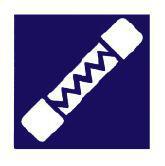 When a wire carries a current, heat is generated. If the current is high and the wire is too thin to cope with it, the wire will get hot—and probably ‘burn out’ or melt.
When a wire carries a current, heat is generated. If the current is high and the wire is too thin to cope with it, the wire will get hot—and probably ‘burn out’ or melt.
A fuse is a deliberate ‘weak link’. If the current rises (usually because a fault has developed) above the intended limit for a fuse, the fuse wire gets very hot, melts and breaks the circuit. This may be caused by:
- ◑ Electricity leaking to earth, either directly, or through the earth wire. The earthed metal casing of an appliance may have become live and the current is returning to earth. This causes an increase in the current because there’s no resistance.
REPLACING A FUSE
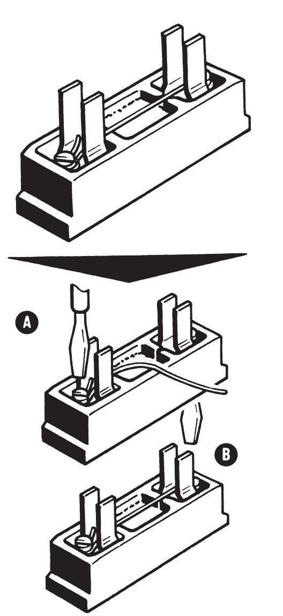
Loosen screws. Remove old wire. Fix new wire at one end (A) with screw. Take wire across, tighten second screw (B). SNIP OFF SPARE WIRE!
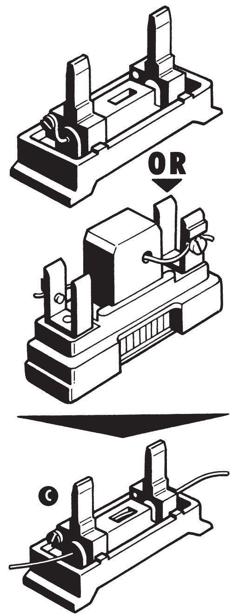
With some types of fuse, it is necessary to thread the new piece of fuse wire through (C). Follow path of old wire or compare to another complete fuse.
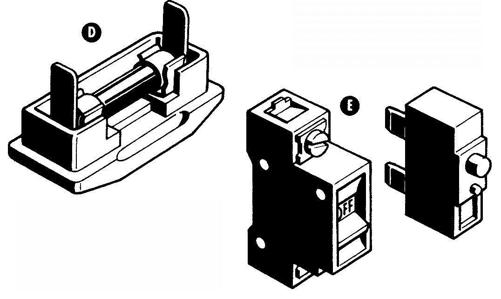
Cartridge fuses (D) need to be removed and replaced. With minicircuit breakers (E), flip switch or press the reset button.
The live and earth wires may have touched in a faulty plug or socket. Spilled water or another conductor may have formed a new connection.
- ◑ Similarly, live and neutral wires may have become connected either directly or through a fault in an appliance.
- ◑ Too heavy a load may have been placed on a circuit—perhaps too many high-powered appliances have been connected to it. The fuse won’t allow the circuit to be endangered by too much current passing through it.
